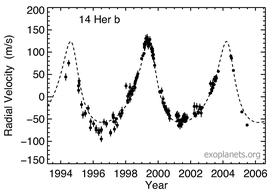astro.wikisort.org - Meteorite
14 Herculis b or 14 Her b is an exoplanet approximately 58.5 light-years away in the constellation of Hercules. The planet was found orbiting the star 14 Herculis, with a mass that would likely make the planet a Jovian planet roughly the same size as Jupiter but much more massive. It was discovered in July 1998 by the Geneva Extrasolar Planet Search team.[4][5] At the time of discovery it was the extrasolar planet with the longest orbital period, though longer-period planets have subsequently been discovered.
 The exoplanet 14 Herculis b (min mass ~4.6 MJ) as rendered by Celestia. | |
| Discovery[1] | |
|---|---|
| Discovered by | Naef et al. |
| Discovery site | |
| Discovery date | 6 July 1998 |
Detection method | Doppler spectroscopy |
| Orbital characteristics[2] | |
Semi-major axis | 2.845+0.038 −0.039 AU |
| Eccentricity | 0.3686+0.0032 −0.0031 |
Orbital period (sidereal) | 4.8277+0.0022 −0.0023 yr |
| Inclination | 32.7+5.3 −3.2 |
Longitude of ascending node | 236±15 |
Time of periastron | 2456667.4+2.3 −2.2 |
Argument of periastron | 22.78+0.53 −0.55 |
| Semi-amplitude | 90.0 ± 0.5[3] |
| Physical characteristics[2] | |
| Mass | 9.1+1.0 −1.1 MJ |
Discovery

14 Herculis b was detected by measuring variations in its star's radial velocity as a result of the planet's gravity. This was done by making precise measurements of the Doppler shift of the spectrum of 14 Herculis. Prior to this analysis, another possible explanation of previous Doppler shift analysis included face-on spectroscopic binaries.[5]
Orbit and mass
Preliminary astrometric measurements made by the Hipparcos satellite suggested that this planet has an orbital inclination of 155.3° with respect to plane of the sky, which would imply a true mass of 11.1 times that of Jupiter, close to the deuterium burning threshold that some astronomers use to define the distinction between a planet and a brown dwarf. However subsequent analysis suggests that the Hipparcos measurements were not precise enough to accurately determine the orbits.[6] According to a 2008 paper, its inclination was being calculated via astrometry with Hubble, with publication expected by mid-2009.[7]
The inclination and true mass of 14 Herculis b were finally measured in 2021, using data from Gaia. The inclination is 32.7°, corresponding to a true mass of 9.1 MJ.[2]
Direct imaging
Because of the wide separation between this planet and its host star, and the proximity of the 14 Herculis system to the Sun, it is a promising candidate for direct imaging of the planet, as the angular separation of the planet and host star will be large enough that the light from the planet and star might be spatially resolved. However, a search made using the adaptive optics CFHT 3.60m telescope on Mauna Kea did not make such a detection, confirming the object is not a star.[1]
References
- "14 Herculis: A new extrasolar planet discovered at the Haute Provence Observatory". Archived from the original on 2 July 2007. Retrieved 28 July 2007.
- Gagliuffi, Daniella C. Bardalez; et al. (1 December 2021). "14 Her: A Likely Case of Planet–Planet Scattering". The Astrophysical Journal Letters. 922 (2). L43. arXiv:2111.06004. Bibcode:2021ApJ...922L..43B. doi:10.3847/2041-8213/ac382c.
- Wittenmyer, R. A.; Endl, M.; Cochran, W. D. (2007). "Long-Period Objects in the Extrasolar Planetary Systems 47 Ursae Majoris and 14 Herculis". The Astrophysical Journal. 654 (1): 625–632. arXiv:astro-ph/0609117. Bibcode:2007ApJ...654..625W. doi:10.1086/509110.
- Mayor, M.; et al. (1998). "Searching for giant planets at the Haute-Provence Observatory". In Hearnshaw, J. B.; Scarfe, C. D. (eds.). Precise Stellar Radial Velocities. IAU Colloqu. 170. San Francisco: ASP.
- Dominique Naef; Michel Mayor; Jean-Luc Beuzit; Christian Perrier; Didier Queloz; Jean-Pierre Sivan; et al. "Extrasolar Planetary Systems or Spectroscopic Binaries? Discrimination using Spectral Line Properties". Archived from the original on 18 May 2011. Retrieved 10 September 2007.
- Pourbaix, D. & Arenou, F. (2001). "Screening the Hipparcos-based astrometric orbits of sub-stellar objects". Astronomy and Astrophysics. 372 (3): 935–944. arXiv:astro-ph/0104412. Bibcode:2001A&A...372..935P. doi:10.1051/0004-6361:20010597.
- Fritz Benedict, G.; McArthur, Barbara E.; Bean, Jacob L. (2008). "HST FGS astrometry - the value of fractional millisecond of arc precision". arXiv:0803.0296v1 [astro-ph]., for "HD 145675 b"
External links
- Jean Schneider (2011). "Notes for Planet 14 Her b". Extrasolar Planets Encyclopaedia. Retrieved 30 September 2011.
- "14 Herculis". SolStation. Archived from the original on 19 July 2008. Retrieved 25 June 2008.
На других языках
[de] 14 Herculis b
14 Herculis b ist ein Exoplanet, der den Hauptreihenstern 14 Herculis umkreist. Auf Grund seiner hohen Masse wird angenommen, dass es sich um einen Gasplaneten handelt. Zum Zeitpunkt seiner Entdeckung im Jahr 1998 war er der Exoplanet mit der größten Umlaufzeit, inzwischen sind aber weitere extrasolare Planeten mit längeren Umlaufzeiten nachgewiesen worden. 2005 wurde mit 14 Herculis c ein zweiter Planet im 14 Herculis-System vorgeschlagen, welcher aber nicht als bestätigt gilt.- [en] 14 Herculis b
[es] 14 Herculis b
14 Herculis b es un planeta extrasolar en órbita alrededor de 14 Herculis. Basándose en su masa, lo más probable es que sea un gigante gaseoso de aproximadamente el mismo tamaño que Júpiter pero mucho más pesado. Fue descubierto en 1998 por el equipo de Búsqueda de Planetas Extrasolares de Ginebra.[2][3] En el momento de su descubrimiento era el planeta extrasolar con el período orbital más largo, aunque desde entonces se han descubierto otros planetas con períodos mayores.[ru] 14 Геркулеса b
14 Геркулеса b — внесолнечная планета в системе оранжевого карлика 14 Геркулеса, находящегося в созвездии Геркулеса на расстоянии ок. 57 св. лет от Солнца.Другой контент может иметь иную лицензию. Перед использованием материалов сайта WikiSort.org внимательно изучите правила лицензирования конкретных элементов наполнения сайта.
WikiSort.org - проект по пересортировке и дополнению контента Википедии